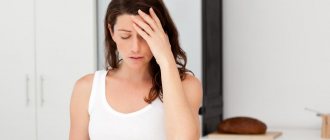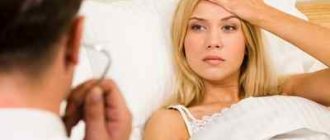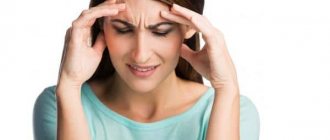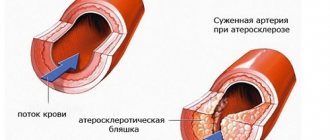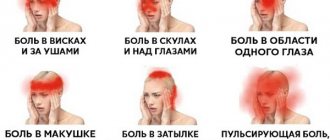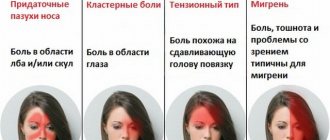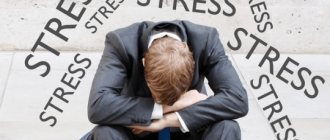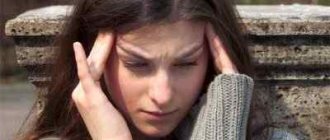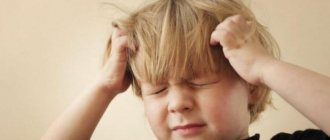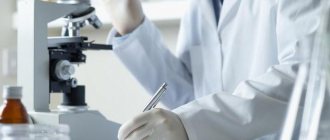Migraine is a disease characterized by recurrent headache attacks with characteristic accompanying symptoms: nausea, vomiting, sensitivity to sounds, light, and smells. The disease is more often diagnosed in women (15% to 7% in men) and affects almost all age groups. In childhood, the problem is more often registered in boys; during puberty, the trend changes towards girls. The peak manifestation of this disease is 30-40 years of age. Migraine without aura (also known as simple migraine, ICD-10 code: G43.0) is more common than with aura (G43.1).
Aura forms and symptoms
Migraine with aura has different symptoms, depending on its clinical form. In practice, the most common:
- Aura with visual disturbances. The classic form is characterized by the appearance of a spot with an uneven or blurred outline, as well as an iridescent or golden color. Scotoma may appear in one or both eyes. The most typical is homolateral localization with subsequent filling of all visual fields. Subsequently, the scotoma disappears and is followed by an attack of cephalgia.
- "Alice Syndrome" Most often this form develops in childhood. Patients complain of distortion of the shape, size, and contours of an object with the appearance of visual hallucinations. Less commonly in clinical practice, a retinal variant with a central scotoma and the onset of transient blindness appears.
- Aura with transient sensory disturbances. It is characterized by changes in the skin sensitivity of the upper shoulder girdle. Concomitant manifestations include the occurrence of visual and auditory hallucinations.
- Aura with temporary speech impairment. Patients note the appearance of aphasia, slower speed of pronunciation of phrases, slurred conversation, and problems with finding words.
- Manifestation of motor disorders. As the disease progresses, increasing weakness develops in the upper and lower extremities on one side.
Pyrethrum herb
The use of the feverfew plant can potentially stop a migraine attack. A few leaves of the medicinal herb are thoroughly chewed. To avoid irritation of the mucous membranes of the oral cavity and prevent the occurrence of a gag reflex, the product is seized with a slice of bread and butter.
The leaves of the plant contain a whole host of substances that have a constricting effect on blood vessels. This effect has a beneficial effect on suppressing headache attacks. As practice shows, using a folk solution for several months makes it possible to completely eliminate the manifestations of migraine.
Attack phases
Migraine, like other diseases, occurs in several successive stages. They successively replace each other. The five stages of migraine with aura include:
- Prodromal symptoms. Patients in this phase note a general deterioration in their condition with increased irritability, causeless deterioration in well-being, as well as mood swings. Against the background of drowsiness during the daytime, daytime sleep worsens. Changes in eating behavior are manifested by a decrease in appetite or its absence. Symptoms are aggravated by exposure to sound or auditory stimuli. In clinical practice, it is possible to stop symptoms at this stage.
- Aura. Its appearance is typical immediately after the end of prodromal symptoms; less often, it develops after a short time. It is accompanied by visual disturbances with the appearance of blind spots or flickering lights. Vision is difficult to focus. This process is two-way. Speech slowing with difficulty in pronunciation may also occur.
- Pain syndrome. The main complaint of patients at this stage is headache. Her character is mostly one-sided. The influence of an auditory, visual or taste stimulus provokes an increase in the intensity of pain. During an attack, the patient may experience nausea, vomiting, and dizziness to the point of loss of consciousness. The pathological process involves the shoulder girdle. The duration of the attack varies, in severe cases it can last up to three days.
- End of the attack. At this stage, the patient notes an improvement in well-being, as the severity of the headache decreases. Restoration of the body is accompanied by an improvement in appetite with a violation of the feeling of satiety. A change in urination is accompanied by an increase in frequency. The duration of the stage is several hours. Its subsidence may be a consequence of taking medications. Self-disappearance is allowed.
Peppermint infusion
Peppermint infusion perfectly relieves paroxysmal headaches. To prepare the product, dry herbal mixture in the amount of half a tablespoon is poured with a glass of boiling water. The container with the composition is tightly covered with a lid and heated for 10-15 minutes in a water bath. Then the product is allowed to cool to room temperature. The liquid is filtered and another glass of boiled water is added. Take the medicine 100 grams 2-3 times a day shortly before meals. The infusion can be stored in a cool place for reuse.
Causes
The exact cause of migraine has not been established.
Helpful information
Most experts are inclined to believe that the disease is based on increased excitability of the cerebral group of pain receptors.
The appearance is associated with the fact that in a separate area of the brain there is a change in the activity of the neuronal apparatus. In this case, the appearance of a visual aura is associated with the fact that neurons in the occipital lobe of the brain are overexcited. Since this area is responsible for processing visual information, the patient notes various types of visual hallucinations. Also, the development of the disease is based on several provoking factors, including:
- Stressful influences. In order to start the pathological process, prolonged stress is required, which the patient experiences with excessive emotionality. As anger, dissatisfaction and irritability accumulate, symptoms develop.
- Mental stress. A patient who has been experiencing fear and anxiety for a long time is faced with a migraine clinic.
- Consumption of foods containing large amounts of tyramine. These include red caviar, bananas, various types of nuts and cheeses, as well as citrus fruits.
- Excessive sexual activity.
- Exposure to harsh noise, smell, light.
- Lack of sleep. Normally, a person needs to sleep at least 8 hours. During sleep, tension in the nervous system is relieved.
- Premenstrual syndrome, taking hormonal drugs as contraception or replacing the lack of one’s own.
- Signs of depressive neurosis, chronic fatigue syndrome, hypochondriacal neurosis.
"Rapimig"
Taking the drug causes blocking of peptides that are responsible for reflex stimulation of the tissues of the membranes of the brain. As a result, migraine attacks stop without the need to relieve pain. Along with the relief of characteristic symptoms, the drug reduces the feeling of nausea, prevents vomiting, and relieves the feeling of nervous irritation in response to bright light and loud sounds.
When a migraine attack develops, take one Rapimiga tablet or 2.5 mg of the active substance. Repeated use of the medication seems to be a rational decision if the signs of the pathological condition again make themselves felt within 24 hours. The maximum permissible dose of a pharmacological agent is two tablets.
Diagnostics
Diagnosis of migraine begins with a consultation with a neurologist. The doctor, talking with the patient, clarifies the main symptoms of the disease, the duration of their appearance, the dynamics of the pathological process, as well as the factors that could provoke the appearance of the clinic. Information about concomitant diseases and lifestyle is of great importance in diagnosis. The doctor examines the patient, determining the main reflexes and palpating trigger points. Selection of additional diagnostic methods to exclude organic pathology, which may have a similar course to migraine. These include:
- Computer or magnetic resonance imaging. Their implementation makes it possible to identify volumetric formations of a malignant or benign nature, their exact localization and connection with vital parts. Also, with tomography it is possible to diagnose cysts, foci of ischemia and the consequences of traumatic exposure.
- Ultrasound examination with Doppler. A non-invasive and accessible method is aimed at studying the vessels that drain and deliver blood to brain cells. Symptoms similar to migraine can develop with stenosis or structural disorders of the vascular wall.
- Ophthalmoscopy. Pathologies of the brain, as well as vascular diseases, can be reflected in the fundus. In addition to visual impairment, it is possible to identify areas of retinal detachment, vascular changes or hemorrhage.
- The only test that can confirm migraine with aura is electroencephalography. During its implementation, information is obtained about the functional activity and characteristics of biological rhythms in various parts of the brain. Electroencephalography is prescribed for the purpose of selecting medications.
Viburnum bark
It is recommended to use the remedy in cases where a migraine attack is already making itself felt. The therapy method allows to reduce the pressure in the blood vessels of the brain tissue. The result is the relief of paroxysmal pain syndrome.
The product is prepared according to the following scheme. Use about a tablespoon of crushed viburnum bark. The raw materials are poured with a glass of boiled water. The resulting mass is placed on low heat and heated for half an hour. The container with the product is removed from the stove, after which it is allowed to brew for 15 minutes. Take the resulting medicine orally, one tablespoon at a time once every 2 hours.
Treatment methods
Migraine with aura is treated using drug and non-drug methods. Areas of drug treatment include pain relief and prevention of recurrence of attacks. The main groups of medicines include:
- Non-steroidal anti-inflammatory drugs. They allow you to relieve the severity of cephalgia. The prescription of non-steroidal drugs is indicated in the initial stages of the disease, when the pain is not pronounced.
- A group of triptans. The use of these drugs is indicated in case of a pronounced deterioration in health, as well as a lack of effectiveness from the therapy.
- Antiemetic drugs. Patients need to use them if they experience nausea or vomiting that does not bring relief.
- Antidepressants and psychotropic drugs. In cases where migraine without aura or with its appearance develops more than twice a month. They are aimed at eliminating provoking factors, as well as reducing the excitability of the nervous system. The selection of a remedy is carried out after a thorough diagnosis and clarification of the possible cause of the disease.
Non-drug treatment methods include:
- Perform acupressure on the affected area. The massage procedure will help reflexively relieve increased stimulation of the nervous system, and will also relax the patient. The average duration of the procedure should be 10-15 minutes, the movements are circular in nature without unnecessary pressure.
- Limiting contact with sound, taste and light stimuli. To do this, you need to lie down in a dark room, protecting yourself from contact with other people and household appliances.
- Dieting. At the first signs of an attack, it is necessary to adhere to a diet with sufficient consumption of clean water. The consumption of smoked, spicy, and sweet foods and alcohol should be avoided.
"Naramiq"
Naramig is an effective anti-migraine medicine that causes constriction of the cerebral arteries and also reduces irritation to the trigeminal nerve. It is the suppression of these factors that helps relieve the main manifestations of migraine.
The pharmacological agent is prohibited from being used to prevent a pathological condition. Take the drug only if the first signs of migraine develop. The tablets are swallowed whole without chewing. The product is washed down with plenty of water. The optimal single dose is 2.5 mg of the active substance. This dose is taken after the onset of an attack. If migraine symptoms return after a short time, take another tablet. Taking more than 5 mg of the pharmacological composition per day is not recommended.
Consequences of advanced migraine
Patients faced with clinical manifestations of the disease need to know what migraine is with or without aura, as well as the dangers of its course without treatment. In the absence of therapy, as well as frequent attacks of cephalgia, the following may occur:
- Stroke. Cerebrovascular accident is accompanied by damage to a separate area of the central nervous system. Symptoms characteristic of a stroke can persist for a long time, worsening the quality of life of the victim.
- Migraine status. In severe cases, cephalalgia persists for several days. Long-term status is accompanied by vomiting, nausea, and weakness. As a result, the patient may experience dehydration or seizures, which require immediate hospitalization and intensive care.
- Depression and anxiety. People who experience frequent cephalalgia note a deterioration in their quality of life and fear of an upcoming attack.
Garlic decoction
A good folk method for suppressing the main symptoms of migraine is the use of garlic broth prepared in milk. The method of treatment is as follows. Take about 10 cloves of garlic. The raw materials are thoroughly crushed using a special crusher. The base of the medicine is poured with milk in an amount of about 50 ml. The composition is placed on the stove and heated over low heat for 2-3 minutes. The product is cooled and then filtered. The resulting substance is instilled into each ear, 5-10 drops. The liquid is held in the ear for a minute, after which the head is tilted and drained.
Prevention
Certain lifestyle changes can prevent migraine symptoms. People can try:
- identify triggers (causes) and, if possible, avoid them;
- practice stress-relieving techniques such as meditation, creative therapy, yoga;
- exercise regularly, avoiding intense exercise, which can trigger migraines;
- go to bed and get up at the same time every day;
- regular meals;
- avoid caffeine and limit alcohol consumption;
- maintaining a healthy body weight.
People who suffer from migraines associated with hormonal fluctuations should talk to a doctor who can help reduce the effects of estrogen.
Cold compresses
You can solve the problem with cold compresses. In order to prevent migraine attacks, a piece of natural fabric is soaked in water. The material is wrung out and applied to the forehead area. The compress is held for several minutes. Then repeat a similar operation. An advisable solution here would be to place a container filled with cold water next to the bed. As a rule, it takes about 15-20 minutes to feel better with this therapy.
Baths with sea salt
A good option for relieving spasmodic headaches is taking a bath with sea salt. It is recommended to resort to the procedure in the evening, shortly before going to bed. It is better to use ordinary sea salt, which does not contain flavorings or any additives. Healing baths are taken every other day for a month. The duration of water procedures should be about 20 minutes.
